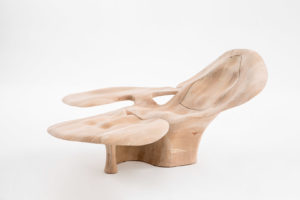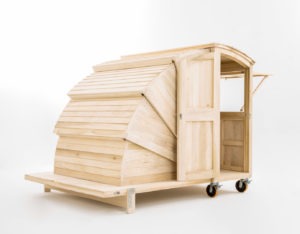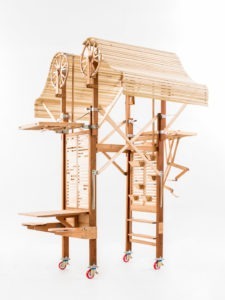When it comes to international promotions, nobody does more inventive work than our sister organization, the American Hardwood Export Council. Last year, in collaboration with the IE School of Architecture & Design in Madrid and the Hay Festival Segovia, Spain, they organized “The Workshop of Dreams,” a poetically named project in which a group of Spanish designers and architects were commissioned by diverse cultural luminaries to create unique sculptural objects made entirely of American hardwoods. The results, all of which were fabricated by Carpintería La Navarra, a renowned specialist woodshop near Madrid, were exhibited at the Museo de Arte Contemporáneo Esteban Vicente during the 2016 Hay Festival Segovia last fall. Subsequently they traveled to the Fundació Enric Miralles in Barcelona and Interzum, the furniture design exposition in Cologne, Germany. Here are my three favorite pieces from “The Workshop of Dreams.”

Commissioned by novelist Javier Cercas and designed by RCR Arquitectes, Cercas Territory is made from American cherry. Photograph courtesy AHEC and Uxío da Vila.
Spanish novelist and academic Javier Cercas was teamed with RCR Arquitectes, a Catalan firm that won the 2017 Pritzker Architecture Prize. Cercas, who spends much of his time reading and writing, dreamed of having a comfortable seat to work in. In talking to the architects, however, this evolved into a desire for a more versatile piece that would allow him to switch between different activities such as relaxing, meditating, reading, or thinking. RCR Arquitectes’ design fused high-tech production methods with the subtlety of natural forms. By electronically scanning the writer’s body and having La Navarra use a computer-controlled machine to carve American cherry, they created Cercas Territory, a complex, ergonomic sculptural form that’s totally tailored to his figure.

Made of American tulipwood, Limiting Factor was commissioned by Juan Luis Arsuaga, Director of the Museum of the Human Evolution in Burgos, Spain, and designed by Jacob Benbunan of branding company Saffron. Photograph courtesy AHEC and Uxío da Vila.
Renowned Spanish paleoanthropologist Juan Luis Arsuaga initial idea was for a portable wooden cabin that covers what he refers to as the “limiting factors,” that is, the basic requirements for human survival so that a person could spend a few days living in the mountains, enjoying nature. Jacob Benbunan, co-founder and CEO of the international branding company Saffron, and his team interpreted Arsuaga’s dream by designing a refuge capable of being taken into and left in the wilds, blending into its natural surroundings. “That way,” Benbunan explained, “architecture gives way to the person and to nature.” The resulting piece, Limiting Factor, comprises a series of fans that unfold to create a sheltering canopy. La Navarra made it entirely of American tulipwood, which is light, meaning the mobile structure weighs relatively little given its volume.

Commissioned by chefs Juan Mari and Elena Arzak, A Window to the Arzak Universe was designed by Madrid-based Izaskun Chinchilla Architects and made of numerous types of American hardwood. Photograph courtesy AHEC and Uxío da Vila.
Juan Mari Arzak and his daughter, Elena, are joint head chefs of three-Michelin-starred restaurant Arzak in San Sebastian. Naturally, their cooking utensils are key in creating the innovative dishes for which they’re famous. “It would be wonderful to have all our utensils close at hand while we are cooking,” Elena pointed out when commissioning Madrid-based architect Izaskun Chinchilla to design A Window to the Arzak Universe. The architect’s airy tower-like structure supports a cloud-like display of kitchen utensils, clearly visible to diners, giving them a better understanding of the process behind each dish. The Window is also directly related to the sustainability of American forests: It incorporates six types of hardwood—tulipwood, red oak, hard maple, soft maple, cherry, and alder—using the most abundant species for the largest elements and the less abundant ones for the smaller pieces.

